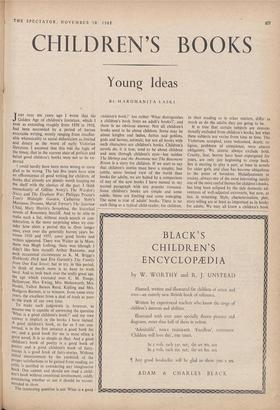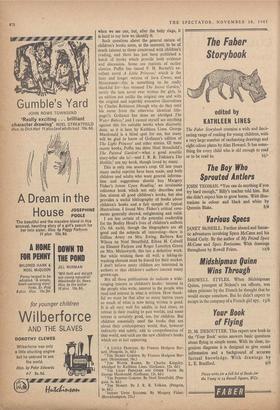CHILDREN'S BOOKS
Young ideas
By MARGHANITA LASKI
UST over ten years ago I wrote that the Golden Age of children's literature, which I took as extending roughly from 1850 to 1910, had been succeeded by a period of barren execrable writing, mostly ranging from insuffer- able whimsicality to social didacticism as limited and dreary as the worst of early Victorian literature. I assumed that this was the logic of the times; that in the current state of politics and belief good children's books were not to be ex- pected.
I could hardly have been more wrong or more glad to be wrong. The last five years have seen an efflorescence of good writing for children, of books that already are plainly worth keeping on the shelf with the classics of the past. I think immediately of Gillian Avery's The Warden's 'Niece and The Elephant War, Philippa Pearce's Tom's Midnight Garden, Catherine Storr's Marianne Dreams, Meriel Trevor's The Sparrow Child, Mary Harris's Seraphina, the historical novels of Rosemary Sutcliff. And to be able to make such a list, without much search or con- sideration, is the more surprising when we con- sider how short a period this is. Over longer ones, even over the generally barren years be- tween 1910 and 1955, some good books and writers appeared. There was Walter de la Mare, there was Hugh Lofting, there was (though I didn't like him myself) Arthur Ransome, and such occasional excitements as K. M. Briggs's Hobberdy Dick and Eve Garnett's The Family from One End Street; but to try, in this period, to think of much more is to have to work hard. And to look back over the really great age, the age which extended over C. M. Yonge, Ballantyne, Mrs. Ewing, Mrs. Molesworth, Mrs. Nesbit, Talbot Baines Reed, Kipling and Mrs. Hodgson Burnett, is to winnow, from some sixty Years, the excellent from a deal of trash as poor as the trash of our own time.
To make such judgments is, however, to assume one is capable of answering the question 'What is a good children's book?' and my own answer is implicit in the books I have named. A good children's book, so far as I am con- cerned, is in the first instance a good book for Hie, and a good book for me is most often a good novel. It is as simple as that. And a good children's book of poetry is a good book of poetry and a good children's book of fairy- stories is a good hook of fairy-stories. Without initial measurement by the yardstick of the proper satisfactions to be gained from reading, no critic is justified in considering any imaginative book. One cannot and should not read a child- ren's book without emotional involvement, coldly considering whether or not it should be recom- mended to them.
The interesting question is not `What is a good children's book?' but rather 'What distinguishes a children's book from an adult's books?', and there is no obvious answer. Not all children's books need to be about children. Some may be about knights and ladies, fairies and goblins, gods and heroes, animals; but not all books with such characters are children's books. Children's novels do, it is true, tend to be about children and seen through children's eyes—but neither The Shrimp and the Anemone nor The Basement Room is a story for children. If we start to say that children's stories must have a simpler, less subtle, more limited view of the world than books for adults, we are halted by a comparison of any of the .new books I have named in my second paragraph with any popular romance. Some children's books are simple and some subtle. Some are limiting and some enlarging. The same is true of adults' books. There is no such thing as a typical child-reader, for children,
in their reading as in other matters, differ as much as do the adults they are going to be.
It is true that certain subjects are conven- tionally excluded from children's books, but what these subjects are varies from time to time. The Victorians accepted, even welcomed, death; re- ligion, problems of conscience, were almost obligatory. We almost always exclude both. Cruelty, fear, horror have been expurgated for years, are only just beginning to creep back. Sex is starting to play a part, at least in novels for older girls, and class has become ubiquitous to the point of boredom. Maladjustment to society; always one of the most interesting, surely one. of the most useful themes for children's books, has long been eclipsed by the s1tfe domestic ad- ventures of well-adjusted extroverts, but now, at last, is returning. Style, characterisation, plot, story-telling are at least as important as in books for adults. We may all know a children's book when we see one, but, after the baby stage, it is hard to say how we identify it.
Such questions about the general nature of
children's books seem, at the moment, to be of much interest to those concerned with children's reading, and there has just been published a batch of books which provide both evidence and discussion. Some are reprints of earlier
classics. Puffin has issued F. H. Burnett's ex- cellent novel A Little Princess.; which is the later and longer version of Sara Crewe, and
Heinemann—this is something to be really thankful for—has reissued The Secret Garden,' surely the best novel ever written for girls, in an edition not unlike the original one and with the original and superbly evocative illustrations by Charles Robinson (though why do they omit his name from the otherwise identical title- page?). Gollancz has done an abridged The
Water Babies,' and I cannot myself see anything against this for suitable books when discreetly done, as it is here by Kathleen Lines. George
Macdonald is a blind spot for me, but many will be glad to know of Gollancz's edition of The Light Princess' and other stories. Of more recent books, Puffin has done Noel Streatfeild's
The Painted Garden'—what a good sensible story-teller she is! —and J. R. R. Tolkien's The Hobbit,' not my book, though loved by many.
This is only one season's crop. Of late years many useful reprints have been made, and both children and adults who want general informa- tion and suggestions should buy Margery Fisher's Intent Upon Reading,' an invaluable reference book which not only describes and lists almost all good children's books, but also provides a useful bibliography of books about
children's books and a fair sample of typical illustrations. I found Mrs. Fisher's critical com- ments generally shrewd, enlightening and valid. I am less certain of the potential readership
for the Bodley Head's lives of children's authors (7s. 6d. each), though the biographers are all good and the subjects all interesting—there is Gillian Avery on Mrs. Ewing, Barbara Ker Wilson on Noel Streatfeild, Eileen H. Colwell on Eleanor Farjeon and Roger Lancelyn Green
on Mrs. Molesworth, this last a definitive work. But while wishing them all well, a taking-in- washing element must be feared for their market. I don't believe many children are interested in authors or that children's authors interest many grown-ups.
But all these publications do indicate a wide- ranging interest in children's books: interest in the people who write, interest in the people who read and interest in what is written. How thank- ful we must be that after so many barren years so much of what is now being written is good.
It is all very well for adults, in bad times, to retreat in their reading to past worlds, and some retreat is certainly good, too, for children. But children essentially need the books that are about their contemporary world, that, however indirectly and subtly, add to comprehension of that world, and such are the new children's books which are at last appearing.
A LITTLE PRINCESS. By Frances Hodgson Bur- nett. (Penguin, 3s. 6d.) 2 THE SECRET GARDEN. By Frances Hodgson Bur- nett. (Heinemann, 16s.)
THE WATER BABIES. By Charles Kingsley. Abridged by Kathleen Lines. (Gollancz, 12s. 6d.) *THE LIGHT PRINCESS AND OTHER TALES. By George Macdonald. (Gollancz, 12s. 6d.) THE PATN1T,D GARDEN. By Noel Streatfcild. (Pen- guin, 3s. 6d.) THE HOBBIT. By J. R. R. Tolkien. (Penguin, 3s. 6d.) T INTENT UPON READING. By Margery Fisher. (Brockhampton, 25s.)











































 Previous page
Previous page